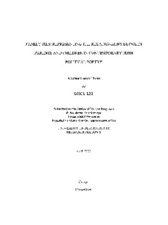| dc.description.abstract | The implications of Irish historical occurrences such as the colonization of the Irish by the English, the partial independence achieved by the Irish in 1922, the subsequent splitting of the island into two separate sections, along with the independence movement of the Irish since 1969 have been left obvious and important influences on the writings of some of the most significant Irish poets since W.B. Yeats. The tendency of the post-Independence generation of Ireland is to epitomize post-revolution nostalgia, idealizing the previous generations' attempt to reclaim their country. Seamus Heaney and Eavan Boland, both from the generation immediately following Irish independence, are sentimental in their portrayals of their parents, and the nostalgia and idealism common to their generation is apparent in their poetry. Important elements in the nostalgic depictions of the generation are the traditional roles of the Irish, not only in the domestic realm but also in occupations and in society in general. Boland and Heaney use the idealized model of the traditional Irish family to represent the Irish nation, describing through personal experience a national significance. This is in contrast to Paul Muldoon, who was born the generation after Boland and Heaney and represents a different viewpoint in his poetry. His view of both nation and family are much more ambivalent, not defining either as ultimately ideal. Though Muldoon does share many of the same concerns as his counterparts, including the disappearance of the Irish tradition due to colonization and emigration, he refuses to solely review the heroics of a nation by depicting them through idyllic images of family. Instead, at times, he presents less flattering images such the one of a woman in the last stages of a hunger strike. Images such as this one are used in order to question the purpose of suffering for such an ambiguous concept as nation. Separated from the move for independence by more than one generation, Muldoon is distanced enough from the efforts to allow for analysis and review of not just the concept of nation and its importance, but also of the stereotypical roles of the family in traditional Ireland. | en |


